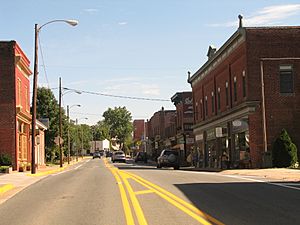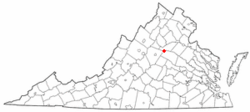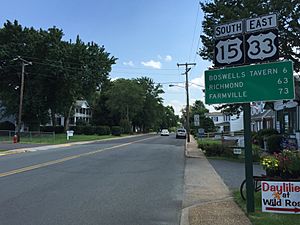Gordonsville, Virginia facts for kids
Quick facts for kids
Gordonsville, Virginia
|
|
|---|---|

Looking down S. Main St
|
|
| Nickname(s):
“Fried Chicken Capital of the Universe”
|
|

Location of Gordonsville, Virginia
|
|
| Country | United States |
| State | Virginia |
| Counties | Orange |
| Area | |
| • Total | 0.95 sq mi (2.46 km2) |
| • Land | 0.95 sq mi (2.46 km2) |
| • Water | 0.00 sq mi (0.00 km2) |
| Elevation | 499 ft (152 m) |
| Population
(2020)
|
|
| • Total | 1,402 |
| • Density | 1,478.9/sq mi (571.0/km2) |
| Time zone | UTC-5 (Eastern (EST)) |
| • Summer (DST) | UTC-4 (EDT) |
| ZIP code |
22942
|
| Area code(s) | 540 |
| FIPS code | 51-31936 |
| GNIS feature ID | 1467264 |
| Website | Official website: http://www.townofgordonsville.org/ |
Gordonsville is a small town in Orange County, Virginia, in the United States. It's about 19 miles northeast of Charlottesville and 65 miles northwest of Richmond. In 2020, about 1,402 people lived there.
In 2013, the town celebrated its 200th birthday! This marked 200 years since Nathaniel Gordon, who owned a local inn, became the area's first postmaster. This officially created the place known as Gordonsville. The town was very important during the Civil War because of its location on the Virginia Central Railroad.
Gordonsville also says it helped make fried chicken popular in the United States. It even calls itself the "Fried Chicken Capital of the World."
Contents
History of Gordonsville
Early Days Before the Civil War
In 1787, a man named Nathaniel Gordon bought 1,350 acres of land. This land was then called "Newville." He bought it from a cousin of President James Madison.
Around 1794, Gordon got a license to open a tavern. A tavern was a place where people could eat, sleep, and talk about local news. His tavern was at a busy crossroads. One road went from Charlottesville to Fredericksburg. The other road went from Richmond west into the Shenandoah Valley.
President Thomas Jefferson even described the tavern as a "good house" in 1802. Many famous Americans visited Gordon's Tavern. These included George Washington, Thomas Jefferson, James Monroe, and Henry Clay. Another important visitor was Major General the Marquis de Lafayette.
In 1813, Gordon became the first postmaster, and the area officially became Gordonsville. When Gordon passed away in 1820, Gordonsville had a tavern, a post office, homes, a general store, and a blacksmith shop. His son, John, inherited the land. Other family members also bought nearby land. This helped the town grow, especially as new roads were built.
In 1839, the General Assembly allowed the Louisa Railroad to extend to Gordonsville. This railroad later became the Virginia Central Railroad. This brought more growth and money to Gordonsville. It became a hub for trade for nearby farms. Two new roads, the Blue Ridge Turnpike and the Rockingham Turnpike, were also built. These connected the town to New Market and Harrisonburg.
In 1854, the Orange & Alexandria Railroad also reached Gordonsville. This connected the town to northern Virginia. Over the next few years, both railroads grew. This made Gordonsville an even bigger transportation center. The train stations were built near what is now S. Main Street.
Nathaniel Gordon's first tavern burned down in 1859. The owner at the time, Richard F. Omohundro, rebuilt it. This new building is now known as the Exchange Hotel. When it opened in 1860, it offered fancy rooms for train passengers and other travelers.
Gordonsville During and After the Civil War
During the Civil War, the Exchange Hotel was used as a hospital. Over 70,000 injured soldiers were cared for there. Today, it's called the Civil War Exchange Museum. It's one of the most important historic buildings in Gordonsville.
Gordonsville and its railroads were very important to the Confederacy. They helped move soldiers and supplies. Famous generals like Robert E. Lee and Stonewall Jackson spent time in Gordonsville. Even though it was threatened many times, the Confederates always defended it successfully.
The Civil War ended in 1865. Gordonsville was mostly undamaged, so train service quickly started again. In 1870, Gordonsville officially became a town. About 1,500 people lived there then. The town grew and had good schools and beautiful buildings. Many of these buildings are still standing today.
In the 1870s, Gordonsville was known for its "fast food." Food sellers would serve travelers on the trains when they stopped in town. Later, new train lines and roads bypassed Gordonsville. It then became a quiet, rural market town. Fires in 1916 and 1920 destroyed much of the downtown area. But the town rebuilt, creating the Gordonsville we see today. The town has stayed strong economically, and its population has remained steady.
In the early 1970s, a group called Historic Gordonsville Inc. was formed. This group works to save and restore historic buildings downtown, including the Exchange Hotel. Their efforts have helped keep Gordonsville's historic center alive.
Important Historic Places
Several places in and near Gordonsville are listed on the National Register of Historic Places. This means they are important to the history of the United States. These include the Gordonsville Historic District, Black Meadow, the Exchange Hotel, and Rocklands.
Geography of Gordonsville
Gordonsville is located at 38°8′5″N 78°11′13″W / 38.13472°N 78.18694°W.
The town covers about 0.9 square miles (2.4 square kilometers). All of this area is land.
People of Gordonsville (Demographics)
| Historical population | |||
|---|---|---|---|
| Census | Pop. | %± | |
| 1880 | 919 | — | |
| 1890 | 962 | 4.7% | |
| 1900 | 603 | −37.3% | |
| 1910 | 564 | −6.5% | |
| 1920 | 594 | 5.3% | |
| 1930 | 462 | −22.2% | |
| 1940 | 508 | 10.0% | |
| 1950 | 1,118 | 120.1% | |
| 1960 | 1,109 | −0.8% | |
| 1970 | 1,244 | 12.2% | |
| 1980 | 1,421 | 14.2% | |
| 1990 | 1,351 | −4.9% | |
| 2000 | 1,498 | 10.9% | |
| 2010 | 1,496 | −0.1% | |
| 2020 | 1,402 | −6.3% | |
| U.S. Decennial Census | |||
In 2010, there were 1,496 people living in Gordonsville. There were 632 households and 388 families. The town had about 1,646 people per square mile.
Most of the people in Gordonsville were White (70.7%). About 23.7% were African American. Other groups made up smaller parts of the population. About 4.3% of the people were Hispanic or Latino.
About 26.3% of households had children under 18 living with them. About 38% were married couples. The average household had 2.37 people. The average family had 3.05 people.
The median age in Gordonsville was 40.8 years old. This means half the people were older and half were younger. About 24.4% of the population was under 18. About 15.6% were 65 or older.
The median income for a household was $41,845. For a family, it was $52,000. About 19.6% of the total population lived below the poverty line.
Getting Around Gordonsville (Transportation)
U.S. Route 15 and U.S. Route 33 are the main roads that go through Gordonsville. US 15 goes north to Orange and south to connect with Interstate 64. US 33 goes west to Stanardsville and east to Louisa. Virginia State Route 231 also serves Gordonsville. It goes north towards Madison and south towards Charlottesville.
Notable People from Gordonsville
- Philip P. Barbour - He was the tenth speaker of the United States House of Representatives. He later became a judge on the United States Supreme Court.
- Ann Marie Calhoun - A talented violinist.
- Marv Goodwin - A professional baseball player.
- Charlie Waller - He founded the famous bluegrass band "The Country Gentlemen."
Climate
Gordonsville has hot, humid summers. Its winters are usually mild to cool. This type of weather is called a humid subtropical climate.
See also
 In Spanish: Gordonsville (Virginia) para niños
In Spanish: Gordonsville (Virginia) para niños


